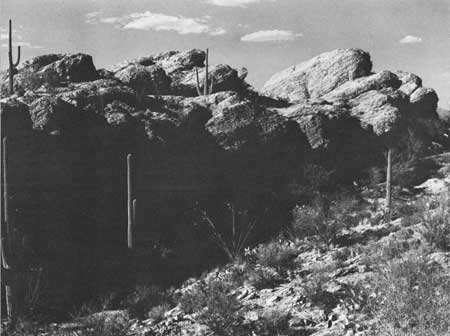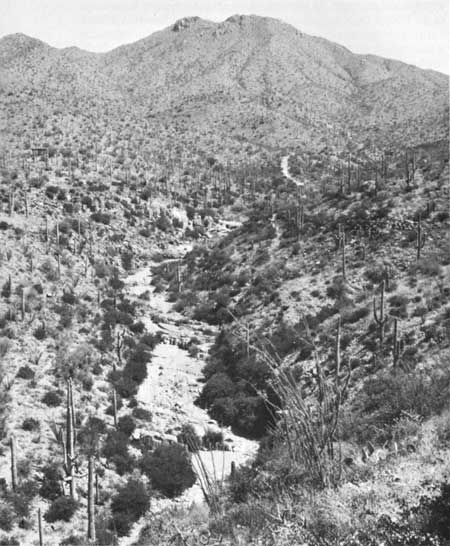|
SAGUARO National Park |
 |
rocks: foundation and soilmakers
Soils are derived from the fragmentation and decomposition of rocks. Combinations of soils and climate, varying from place to place, create an almost infinite number of environments with differences so subtle and small as to make it appropriate to refer to them as microenvironments. Though these differences be minor, they are often sufficient to create niches each of which becomes a habitat for a particular group of plants and animals. Thus it is that the saguaros and other desert vegetation in Saguaro National Monument and vicinity are found in particular environmental or ecological niches where just the right combinations of soils, moisture, sunlight, temperature and other factors are present.
Since the rocks provide the foundation and the source of soils that support the plant and animal life, it is helpful to understand something about the origin and evolution of the rocks and the landscape of which they are a part. Clues to this story are to be found in the composition of the rocks and their relationships to one another.
 Banded augen gneiss on Cactus Forest Drive. Javelinas formerly took refuge from the sun in the dens under these overhanging rocks. (Photo by Ray Manley) |
Rocks of the three major classes—igneous, metamorphic, and sedimentary—are found within the monument. The igneous rocks include granites and various kinds of lava flows, together with some intrusive dikes and veins. The metamorphic rocks are represented by gneiss and schist. Lastly, sedimentary rocks occur as limestone, sandstone, and alluvial fill material. Each of these great classes of rocks was formed in a different manner, and these differences reveal the nature of the events which are a part of the geologic history of the monument and surrounding area.
Catalina Gneiss (pronounced NICE) is the predominant rock that visitors see in the Rincon Mountains and the Tanque Verde Ridge; exposures of granite and schist are also found. Gneiss is a coarse grained metamorphic rock resembling granite, having a banded appearance, and consisting of alternating layers of different minerals such as feldspar, quartz, mica, and hornblende. The banding and texture reveal that the gneiss, now exposed by uplift and erosion, was formed from parent rocks deep below the earth's surface during the Precambrian Era more than a half billion years ago. There the parent rocks, subjected to pressure and heat, melted, flowed, and crystallized, before resolidification.
Though the gneiss of the Rincon Mountains is ancient, the uplift that raised it to its present height is thought to have occurred rather recently (within the past 24 million years), during the period when most of the Sonoran Desert ranges apparently were formed. In age, these mountains thus would fall somewhere between the older Rockies and the younger Sierra Nevada.
The schist, which underlies much of the Cactus Forest, where it is exposed along washes, was probably formed during the Cretaceous period more than 65 million years ago. Like the gneiss, the schist is a metamorphic rock, having been formed by the transformation of parent rocks at depth under great pressure and heat. Due mainly to differences in the composition of the parent rock, together with its mica content, the rock that resulted was platy and cleavable (accounting for its classification as schist).
Granite, which forms Wasson and Amole peaks in the Tucson Mountain Section, is an igneous rock that (like the metamorphic gneiss and schist) originated at depths below the earth's surface. The granite was formed by the solidification of molten rock material that moved upward en masse from greater depths, rather than by the alteration of ancestral rocks. Erosion of the uplifted land mass has not only stripped away the overburden but has developed valleys deeply incised into the granite itself.
Volcanic rocks in the form of rhyolite, andesite, and basalt flows also are exposed, chiefly in the Tucson Mountain section of the monument. These are all extrusive igneous rocks composed of magma that solidified after reaching the earth's surface through vents or fissures. There are differences in the lava flows, reflecting differences in composition, temperature, and other conditions of the magma from which they were formed. The rhyolite is lighter in color than andesite, and it is somewhat richer in feldspar. Basalt, on the other hand, is dark, is deficient in feldspar and quartz, and contains relatively large amounts of the darker minerals such as hornblende, pyroxene, and olivene. Lava flows of the rhyolite and andesite variety occur in the Cactus Forest locality of the Rincon Mountain Section. Cat Mountain Rhyolite is the name given to a rhyolite flow of Tertiary age that forms the topmost layer in much of the Tucson Mountain Section. A small exposure of basalt is also found here.
Limestone, sandstone, and shale formations are also exposed at various places within the monument. They are reliable indicators of seas that covered the area during one or more times of the geologic past. Comparisons with the limestone formations farther to the south in the Colossal Cave region indicate that the limestone in the monument was formed as far back as late in the Paleozoic Era (345 million years or more ago). This age is suggested by types of fossils, including fragments of crablike trilobites and crinoid (sea lily) stems, found in limestones of the same age near Colossal Cave.
The Recreation Redbeds of the Tucson Mountain Section is one of the important sandstone members exposed in the monument. Geologists believe that its deposition occurred early in the Cretaceous Period more than 65 million years ago. Above the Recreation Redbeds lies a formation consisting mainly of limestone and commonly known as the Tucson Mountain "Chaos"—an appropriate name, in view of the geologists' meager knowledge of it. Within the Chaos formation, believed to be lower to Middle Tertiary in age, are limestone blocks of greater age than the rocks within which they are entombed. No generally accepted explanations have been advanced as to how these relationships developed.
 During summer, mule deer and javelina frequent King Canyon, which has the only known permanent spring in the Tucson Mountains. The predominant rock in this major canyon northeast of the Arizona-Sonora Desert Museum is called Amole Arkose; it is of sedimentary origin and was deposited during the Cretaceous period. |
The processes that destroy mountains continue concurrently with those that build them. Temperature changes, weathering, and downslope creep under the influence of gravity are among the agents which destroy the rocks and eventually convert them into soil. Though these processes work rapidly from a geological standpoint, in terms of the average human life span, they progress at an imperceptible rate. Violent thunderstorms and cloudbursts, however, cause a massive, often spectacular movement of boulders, gravel, sand, and silt by torrential streams.
In desert regions, most of the runoff from storms sinks into the slopes, dropping its burden along the way. Big rocks are dropped early as the carrying power of the water diminishes with the speed of flow; smaller fragments travel farther. The finest material is carried far out into the basins between mountain ranges, gradually filling them. (The alluvial material in the Tucson Basin is estimated to be 2,000 to 5,000 feet thick.) Thus desert mountains tend to bury themselves in their own debris.
Alluvial fans (fan-shaped deposits built by rivers flowing from mountains into lowlands) form at the mouths of canyons. Sometimes the alluvial fans of adjacent canyons coalesce, forming the long, sweeping slope known as a bajada (pronounced ba-HA-da). In other places the eroded bedrock extends outward from the bases of desert mountains, forming "pediments," which are usually covered by a veneer of alluvial material. Pediments of this kind stretch from the lower slopes of the Rincon Mountains. In the Tucson Mountains the alluvial material deepens rapidly toward the Avra Valley because the bedrock at the base of the mountain dips steeply downward.
Serious gaps remain in the story of the origin and evolution of the landscape in Saguaro National Monument. Moreover, it is difficult to establish the exact sequence in which the various events occurred. The composition, texture, and relationships of the rocks, however, do reveal much about the nature of the events and the processes that were involved.
 GEOLOGICAL CROSS-SECTION OF SANTA CRUZ VALLEY |
The presence of the limestones and sandstones indicates that that area was submerged below the water of ancient seas one or more times in the geologic past. The gneiss, schist, and granite bespeak deep-seated metamorphism and magmatic intrusion, which gave these rocks the form, composition, and texture they possess today. The lava flows are indicative of volcanic activity that was a part of the extensive volcanism that occurred in this part of southern Arizona. And, finally, the great alluvial fans and bajadas suggest that these mountain ranges could bury themselves in their own products of erosion unless the mountain-building processes in future eons continue at a faster pace than the wearing-down processes. This evidence enables us to perceive today's landscape as but a transitional phase in the drama of change that will continue for milleniums.

|

|
|
|
|
Last Modified: Sat, Nov 4 2006 10:00:00 pm PST |


